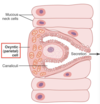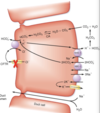Secretions of GI Tract and Pancreas (Lopez) Flashcards
What are the functions of saliva?
- initial digestion of starches and lipids
- dilution and buffering of ingested foods
- lubrication of ingested food w/ mucus
What are the 3 major salivary glands and their function?
- parotid glands: composed of serous cells; secrete fluids composed of water, ions, and enzymes (rich in amylase); secrete 25% of daily output of saliva
- submaxillary and sublingual glands (mixed glands): composed of serous and mucus cells; secrete aqueous fluid and mucin glycoprotein for lubrication; secrete 75% of daily saliva output
What is the structure of salivary glands?
- acinus (blind end): acinar cells secrete initial saliva
- myoepithelial cells: have motile extensions, when stimulated by neural input they contract to eject saliva into mouth
- intercalated duct: saliva in ID is similar in ionic composition to plasma
- striated duct: lined by columnar epithelial cells (ductal cells); ductal cells modify the initial saliva to prod final saliva (hypotonic); ductal cells alter conc of various electrolytes

What is the composition of saliva?
- composed of H2O, electrolytes, α-amylase, lingual lipase, kallikrein, and mucus
- hypotonic compared to plasma: higher level of K+ and HCO3- conc; lower level of Na+ and Cl- conc

What is the mechanism of salivary secretion?
two main steps:
1) formation of isotonic plasma-like solution by acinar cells
2) modification of isotonic solution by ductal cells

How does saliva become hypotonic as it flows through the ducts?
- transport mechanisms results in combined action of absorption of Na+ and Cl- and secretion of K+ and HCO3-
- there is net absorption of solute (more NaCl is absorbed than KHCO3 secretion)
- ductal cells are H2O impermeable, meaning solutes can flow via transport mechanisms without osmosis occuring and changing the intended solute conc

What are the transport mechanisms on the lumen (apical side) and blood (basolateral side) of the salivary ductal cell?
- lumen (apical side): Na+/H+ exchange, Cl-/HCO3- exchange, H+/K+ exchange (HCO3- leaves the cell via cAMP-activated CFTR Cl- channel (not shown) or via the Cl-/HCO3- exchanger)
- blood (basolateral side): Na+/K+ ATPase, Cl- channels

What is the innervation to the salivary glands?
- parasympathetic: presynaptic nerves originate at facial and glossopharyngeal nerves, postsynaptic fibers in autonomic ganglia innervate individual glands
- sympathetic: preganglionic nerves originate at cervical ganglion, who postganglionic fibers extend to glands in the periarterial spaces

How is salivary secretion regulated and what factors influence regulation?
- regulation of salivary secretion is by the ANS
- (+) conditioning, food, nausea, smell
- (-) dehydration, fear, sleep
- parasympathetic: both activators and inhibitors of salivary secretion influence the parasympathetic NS (these effects dominate);
regulated via CN VII and CN IX > ACh released > atropine inhibits mAChR > mAChR activates IP3 which increases Ca2+ (within acinar or ductal cells) > saliva
- sympathetic: regulated by nerves from T1-3 > NE released > activates βAR > activates cAMP (within acinar or ductal cells) > saliva
- stimulation of salivary cells results in: increased saliva prod, increased HCO3- and enzyme secretions, and contraction of myoepithelial cells

What are the 2 unique features in regulation of salivary secretion?
- salivary regulation is exclusively under the control by ANS
- salivary secretion is increased by both parasympathetic and sympathetic stimulation: generally, PSNS and SNS have opposite actions (but not in this case)
What is the main composition of gastric juice (secreted by gastric mucosa)?
- HCl (H+): w/ pepsin, initiates protein digestion; necessary for conversion of pepsinogen to pepsin; kills large number of bacteria that enter stomach
- pepsinogen: inactive precursor
- mucus: lines the wall of the stomach and protects it from damage; lubricant; w/ HCO3-, neutralizes acid and maintains surface of mucosa at neutral pH
- intrinsic factor: required for absorption of vit B12 in ileum
- H2O: medium for action of HCl and enzymes; solubilizes much of ingested material
What are the divisions of gastric mucosa?
- oxyntic gland: located in proximal 80% of stomach (body and fundus), secretes acid
- pyloric gland: located in distal 20% of stomach (antrum), synthesizes and releases gastrin

Which cells of gastric mucosa secrete each component of gastric juice?
- parietal cells: intrinsic factor and HCl
- chief cells: pepsinogen
- G cells: gastrin (to circulation)
- mucus cells: mucus, HCO3-, pepsinogen

- major function of these cells is to secrete HCl
- the number of these cells determine the maximal secretory rate
- function of low gastric pH (1-2) is to convert pepsinogen to pepsin
- HCl is formed at the villus-like membranes of the canaliculi
parietal cells

What is the mechanism of HCl secretion by gastric parietal cells?
(on basolateral side):
- K+ brought into cell via Na+/K+ ATPase
- HCO3- exchanged for Cl- and absorbed into blood (“alkaline tide”)
(within parietal cell, reversible reaction):
- CO2 + H20 converted to H2CO3 by carbonic anhydrase
- H2CO3 converted to H+ and HCO3-
(on apical side):
- H+ exchanged for K+ and secreted (inhibited by Omeprazole)
- Cl- follows H+ and combines to form HCl
result:
- net secretion of HCl and net absorption of HCO3-

What is the two-component model of gastric secretion?
gastric juice can be seen as a mixture of 2 separate secretions:
- non-parietal: basal alkaline secretion of constant and low volume; primary constituents are Na+ and Cl-, K+ is present at same conc as plasma; HCO3- is secreted at conc of ~30 mEg/L
- parietal: slightly hyperosmotic; contains 150-160 mEq H+/L and 10-20 mEq K+/L; Cl- is the only anion present; as secretion rate increases, the conc of electrolytes begin to approach those of pure parietal cell secretion
What factors regulate H+ secretion by gastric parietal cells?
- vagus n. > ACh release (inhibited by Atropine) > M3 receptor > Gq > IP3/Ca2+ > (+) H+/K+ ATPase > (+) H+ secretion
- G cells (inhibited by somatostatin) > gastrin > CCKB receptor > Gq > IP3/Ca2+ > (+) H+/K+ ATPase > (+) H+ secretion
- ECL cells > histamine (inhibited by Cimetidine) > H2 receptor > Gs > activates cAMP > (+) H+/K+ ATPase > (+) H+ secretion
(ECL cells: activated by ACh and gastrin; inhibited by prostaglandins and somatostatin)
- D cells > somatostatin > ? receptor > Gi > inhibits cAMP > (-) H+ secretion
- prostaglandins > ? receptor > Gi > inhibits cAMP > (-) H+ secretion
- H+ secretion inhibted by Omeprazole
*there is a passive feedback mechanism regulating HCl secretion: as pH falls, gastrin release is inhibited which decrease HCl secretion*

Describe the role of the vagus n. in HCl secretion from parietal cells:
role of vagus n. is twofold:
1) direct pathway: vagus n. stimulates release of ACh (inhibited by Atropine) > ACh activates parietal cells to release HCl
2) indirect pathway: vagus n. stimulates release of GRP > activates G cells to produce gastrin > gastrin enters circulation > acts on parietal cells to release HCl
(atropine will not block vagal effects on gastrin secretion within indirect pathway bc the NT at the synapse on G cells is GRP)

Describe the regulation of gastrin release:
- somatostatin acts on G cells to inhibit gastrin release
- vagal activation stimulates gastrin release by releasing GRP and inhibiting release of somatostatin
- negative feedback by gastrin: gastrin itself increases somatostatin
- H+ in gastric lumen stimulates release of somatostatin (indirect inhibition)

What is the role of histamines, ACh, and gastrins in the secretion of HCl and what are pharmacological implications of this?
- potentiation: combined reponse to 2 stimulants exceeds sum of individual responses; requires the presence of separate receptors on target cell for each stimulant
- example: histamine potentiates actions of ACh and gastrin; ACh potentiates actions of histamine and gastrin
- pharmacological implications: antagonists of H2 receptors (e.g. Cimetidine) block direct action of histamine and also block potentiated effects of ACh and gastrin; antagonist of mAChRs (e.g. Atropine) block direct effects of ACh and ACh-potentiated effects of histamine and gastrin
- anatagonist of H2 receptors (histamine receptors)
- used to treat duodenal and gastric ulcers, and GERD
Cimetidine

- inhibits H+/K+ ATPase
- used to treat ulcers by reducing H+ secretion
Omeprazole
What are the 3 phases of gastric HCl secretion?
- cephalic phase via vagus: parasympathetics excite pepsin and acid prod
- gastric phase: 1) local nervous secretory reflexes, 2) vagal reflexes, 3) gastrin-histamine stimulation; products enter circulation
- intestinal phase: 1) nervous mechanisms, 2) hormonal mechanisms

What are highlights of mechanism for stimulating HCl secretion per phase?



















